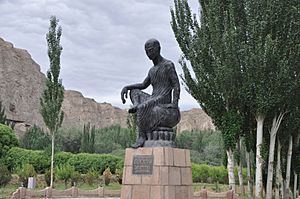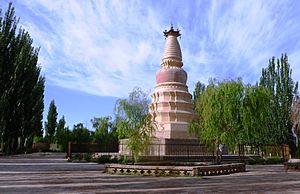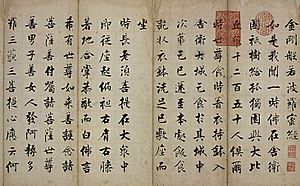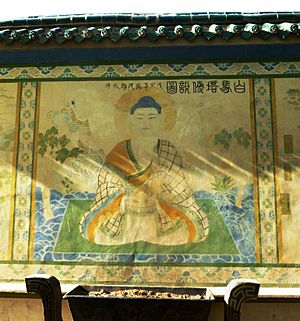Kumārajīva facts for kids
Quick facts for kids
Kumārajīva
|
|
|---|---|

|
|
| Born | 344 CE |
| Died | 413 CE (aged 68-69) |
| Occupation | Buddhist monk, scholar, translator, and philosopher |
| Known for | Translation of Buddhist texts written in Sanskrit to Chinese, founder of the Sanlun school of Mahayana Buddhism |
Kumārajīva (Sanskrit: कुमारजीव; traditional Chinese: 鳩摩羅什; simplified Chinese: 鸠摩罗什; pinyin: Jiūmóluóshí; Wade–Giles: Chiu1 mo2 lo2 shih2, 344–413 CE) was a Buddhist monk, scholar, missionary and translator from the Kingdom of Kucha (present-day Aksu Prefecture, Xinjiang, China). Kumārajīva is seen as one of the greatest translators of Chinese Buddhism. According to Lu Cheng, Kumarajiva's translations are "unparalleled either in terms of translation technique or degree of fidelity".
Kumārajīva first studied teachings of the Sarvastivadin schools, later studied under Buddhasvāmin, and finally became an adherent of Mahayana Buddhism, studying the Mādhyamaka doctrine of Nāgārjuna. After mastering the Chinese language, Kumārajīva settled as a translator and scholar in Chang'an (c. 401 CE). He was the head of a team of translators which included his amanuensis Sengrui. This team was responsible for the translation of many Sanskrit Buddhist texts into Chinese.
Kumārajīva also introduced the Madhyamaka school of Buddhist philosophy into China which would later be called Sanlun (the "Three Treatise school").
Contents
Life
Early life
Kumārajīva's father Kumārāyana was from ancient India, probably from present-day Kashmir, his father was an Indian prince, the son of a high minister, whom the king of Kucha pressured to marry his younger sister and so his mother was a Kuchan princess and devout Buddhist who significantly influenced his early studies. His grandfather Ta-to is supposed to have had a great reputation. His father became a monk, left Kashmir, crossed the Pamir Mountains and arrived in Kucha, where he became the royal priest. The sister of the king, Jīva, also known as Jīvaka, married him and they produced Kumārajīva. Jīvaka joined the Tsio-li nunnery, north of Kucha, when Kumārajīva was just seven.
As a young boy (beginning at the age of 9), Kumārajīva studied the Agamas and the Sarvastivada Abhidharma under masters in North India, Kashmir and Kucha, which were centers of Sarvastivada monasticism and scholarship. He later converted to and studied Mahayana under the Kashmirian Buddhayaśas in Kashgar. He received full monastic ordination at the age of 20 in Kucha and also studied the Sarvastivada Vinaya along with the Madhyamaka philosophy. Over time he became a famous figure known for his broad learning and skill in debate.
Capture, Imprisonment and Release

In 379 CE, Kumārajīva's fame reached China when a Chinese Buddhist monk named Seng Jun visited Kucha and described Kumārajīva's abilities. Efforts were then made by Emperor Fu Jian (苻堅) of the Former Qin Dynasty to bring Kumārajīva to the Qin capital of Chang'an. To do this, his general Lü Guang was dispatched with an army in order to conquer Kucha and return with Kumārajīva. Fu Jian is recorded as telling his general, "Send me Kumārajīva as soon as you conquer Kucha." However, when Fu Jian's main army at the capital was defeated, his general Lü Guang declared his own state and became a warlord in 386 CE, and had Kumārajīva captured when he was around 40 years old. Being a non-Buddhist, Lü Guang had Kumārajīva imprisoned for many years, essentially as booty. During this time, it is thought that Kumārajīva became familiar with the Chinese language. Kumārajīva was also coerced by Lü into marrying the Kucha King's daughter, and so he was forced to give up his monk's vows.
After the Yao family of Former Qin overthrew the previous ruler Fu Jian, the emperor Yao Xing made repeated pleas to the warlords of the Lü family to free Kumārajīva and send him east to Chang'an. When the Lü family would not free Kumārajīva from their hostage, an exasperated Yao Xing had armies dispatched to Liangzhou in order to defeat the warlords of the Lü family and to have Kumārajīva brought back to them. Finally the armies of Emperor Yao succeeded in defeating the Lü family, and Kumārajīva was brought east to the capital of Chang'an in 401 CE.
Chang'an and Translation work

At Chang'an, Kumārajīva was introduced to the emperor Yao Xing, the court, and the Buddhist leaders. He became a famous and well respected in China, being given the title of "National Preceptor" (guoshi). At Chang'an, Kumārajīva led a court sponsored translation team of scholars who worked on translating numerous Sanskrit Buddhist texts into the Chinese language. Yao Xing looked upon him as his own teacher, and many young and old Chinese Buddhists flocked to him, learning both from his direct teachings and through his translation bureau activities at the Xiaoyao Gardens where daily sessions were held (attended by over a thousand monks). Within a dozen years, Kumārajīva's translation bureau had translated about thirty five sutras in 294 scrolls. His translations are still in use today in Chinese Buddhism. Kumarajiva had four main disciples who worked on his team: Daosheng (竺道生), Sengzhao (僧肇), Daorong (道融), and Sengrui (僧睿).
Scholarly work

Translation
Kumārajīva revolutionized Chinese Buddhism, and his team's translation style is known for its clarity and for overcoming the previous "geyi" (concept-matching) system of translation which matched Buddhist terminology with Daoist and Confucian terms. Kumārajīva's readable translation style was distinctive, possessing a flowing smoothness that reflects his prioritization on conveying the meaning as opposed to precise literal rendering. Because of this, his renderings of seminal Mahāyāna texts have often remained more popular than later, more literal translations, e.g. those of Xuanzang.
Kumārajīva's translations were very influential on the development of Buddhist Chinese and they introduced much commonly used terminology, such as:
- 大乘 ''Dà chéng'', or "greater vehicle," for the Sanskrit term Mahāyāna
- 念處 "niàn chǔ" for smṛtyupasthāna (placement of mindfulness)
- 菩提 "pú tí" for Bodhi (awakening)
- 性 "xìng" for dhatū (nature, source)
These translations were a group effort and therefore it is more accurate to say that they were translated by a committee which was guided by Kumārajīva, not by Kumārajīva alone. The process of translation began with the reading of the text by Kumārajīva who would also give a running commentary in Chinese. The Chinese monks and students would discuss the text with Kumārajīva and among themselves. A translation in Chinese would emerge from this process, which would be checked by Kumārajīva. The text was then written down and revised numerous times. These were also public events which were attended by devotees, including emperor Yao Xing.
Kumārajīva also developed a system of transcription in order to render Sanskrit terms in Chinese by using certain Chinese characters and their sounds to represent each syllable of a foreign word. This system would go on to become the basis of the development of pinyin romanization. This encounter with Sanskrit influenced the development of the Chinese language itself, not only in the adoption of specifically Buddhist terms, but also regarding certain secular terms as well (such as "moment").
Kumārajīva has sometimes been regarded by both the Chinese and by western scholars as abbreviating his translations, with later translators such as Xuanzang being regarded as being more "precise."
Translated Texts
According to John M. Thompson "at present there are fifty two translations in the Taishō under his name and their authenticity is fairly well accepted." They include Mahāyāna sutras as well as works on Buddhist meditation (dhyāna) and Abhidharma.
Sutras
Among the most important sutras translated by Kumārajīva and his team (probably from Kuchan target sources) are the following:
- Vajracchedikā Prajñāpāramitā Sūtra (Diamond Sutra)
- Smaller Sukhāvatī-vyūha (T 366)
- Saddharma Puṇḍarīka Sūtra (Lotus Sutra) (T 263—62)
- Vimalakirti Nirdesa Sutra (T 475)
- Aṣṭasāhasrikā Prajñāpāramitā Sūtra, (T 227, 408 CE)
- Pañcaviṃśatisāhasrikā Prajñāpāramitā Sūtra (T 223, 403-404 CE)
- Śūraṅgama Samādhi Sūtra (T 642)
- Daśabhūmikā Sūtra (T 286) in collaboration with Buddhayaśas.
- Acintyaprabhāsa-nirdeśa-sūtra (T 484)
- Viśeṣacintā-brahma-paripṛcchā (T 585—86)
- Bhadrakalpa (T 425)
- Vasudhara-sūtra (T 481—82)
- Pūrṇa-paripṛcchā ( T 310, 17)
- Ratnajāli-paripṛcchā (T 433)
- Vidhi-hṛdaya-vyūha (T 307)
- Sarva-puṇya-samuccaya-samādhi-sūtra (T 381—82)
- Maitreyavyākaraṇa Sūtra
Treatises
They also translated several key treatises (mainly of the Madhyamaka school), which became the central works of East Asian Madhyamaka Buddhism. These are:
- The Middle Treatise (Ch. 中論, pinyin: Zhonglun, T. 1564; Skt. Madhyamakaśāstra), comprising Nāgārjuna's Mūlamadhyamakakārikā ("Fundamental Verses on the Middle Way") alongside a commentary by *Vimalākṣa / *Piṅgala (Ch. 青目, pinyin: Qingmu).
- The Treatise on the Twelve Gates (Ch. 十二門論, pinyin: Shiermenlun, T. 1568), allegedly Nāgārjuna's *Dvādaśadvāraśāstra, also reconstructed as *Dvādaśamukhaśāstra or as *Dvādaśanikāyaśāstra.
- The Hundred(-Verse) Treatise (Ch. 百論, pinyin: Bailun, T. 1569; Skt. Śatakaśāstra, or Śataśāstra), consisting of a commentary by a certain master Vasu on some verses by Āryadeva.
- "Commentary on the Great Perfection of Wisdom" (Ch. 大智度論, pinyin: Dazhidulun, T. 1509; Skt. Mahāprajñāpāramitopadeśa). A commentary on the Pañcaviṃśatisāhasrikā Prajñāpāramitā Sūtra attributed to Nāgārjuna, but this attribution is disputed by some modern scholars.
- Satyasiddhi Shastra (Ch'eng-shih lun) - this Abhidharma text, while not being a work of Madhyamaka, was influential on Chinese Madhyamaka, since it also taught the emptiness of dharmas.
Other treatises that the team worked on include the Daśabhūmika-vibhāṣā (T 1521), a commentary to the Daśabhūmikā Sūtra attributed to Nagarjuna and the Treatise On Arising Bodhicitta (T.1659).
Meditation texts
Kumārajīva and his team also translated some treatises on meditation (dhyāna). In the Taisho Tripitaka (vol. 15), five meditation works are attributed to Kumārajīva:
- Scripture of the Secret Essentials of Dhyāna (T613. Chan mi yao fa jing 禪祕要法經)
- Scripture on the Samādhi of Sitting Dhyāna (T614. Zuòchán sān mēi jīng 坐禪三昧經), ZSJ (also called the Bodhisattvadhyāna Pusa Chanfa Jing 菩薩禪法經 or The Scripture on the Practice of Dhyāna in The Wilderness E lan Rou Xi Chan Fa Jing 阿蘭若習禪法經).
- Essential Explanation of The Method of Dhyāna (T616. Chán fǎ yào jiě 禪法要解).
- The Abridged Essence of Dhyāna (T617. Siwei Lue Yao Fa 思惟略要法)
Scholars are divided on how many of these were actually worked on by Kumārajīva (though T613 and T614 are well attested in early catalogs and prefaces). Furthermore, Chinese sources indicate that these works were edited, summarized and extracted from Indian sources. Eric Greene explains that the main methods of mediation taught in T614 are the “five gates of chan” (五門禪) "associated with the so-called yogācāras of northwest India," which "became a standard arrangement in later writings on meditation" and are the following:
- the cultivation of love (ci xin 慈心; the four apramāṇa meditations) for those with aversion,
- the contemplation of dependent origination (yin yuan 因 緣; pratītyasamutpāda) for those with ignorance,
- meditation on the breath (nian xi 念息; ānāpāna-smṛti) for those with “excessive thinking” (多思覺人; vitarka), and
- recollection of the Buddha (nian fo 念佛; buddhānusmṛti) for those with “equally distributed” (等分) defilements.
After having calmed the mind and entered dhyāna (chan 禪) through these methods, the meditator then proceeds to develop wisdom (prajñā) by cultivating the four “foundations of mindfulness” (si nian chu 思念處; smṛtyupasthāna). According to Greene, "following this, one moves through the so-called four nirvedha-bhāgīya-kuśalamūla (si shan gen 四善根), the “roots of good that lead to liberation,” which in the Sarvāstivādin system are the highest levels of mundane accomplishment. This in turn leads to the so-called “path of vision” (darśana-maraga), a sequence of sixteen mental moments in which, by means of insight into the four noble truths."
While T614 discusses the path of hinayana as well as the bodhisattva path, the actual meditation practices are not different, they are just approached in different ways. For example, the bodhisattva practices the same contemplation of impurity as the sravaka, but they are also warned not to become so disgusted with the world that they seek immediate nirvāṇa. Instead, a bodhisattva should always practice these meditations with the wish for perfecting themselves in order to help others. As such, Kumārajīva seems to have understood the practice of a bodhisattva to have consisted of the same methods of meditation found in śrāvaka-yāna sources, the only difference being that bodhisattvas have a different motivation and a different goal (Buddhahood).
Other
Other translations include the Da zhuang yan jing lun 大莊嚴經論 (*Mahālaṃkāra-sūtra-śāstra) of Asvaghosa and Samyukta avadana sutra.
Original works and philosophy

Kumārajīva is also known to have authored a few original works, including his Commentary on the Vimalakīrti-nirdesa-sūtra (Zhu Weimojie Jing. Taisho number 1775) and the Shixiang lun (Treatise on Tattva, now lost). Kumārajīva and his team are also responsible for a biography of Nagarjuna (T 2047), which may have been based on Kumārajīva's own accounts to his students.
Another text which contains some original teachings by Kumārajīva is the Jiumoluoshi fashi dayi (The Great Teaching of Dharma Master Kumārajīva; T no. 1856), which is a series of letters between Kumārajīva and Lushan Huiyuan (334-416) discussing some basic Mahayana topics.
Regarding Kumārajīva's own philosophical views, according to Richard H. Likewise, according to John M. Thompson, the philosophy which emerges from the explanations of Kumārajīva is "virtually identical to the views of Nagarjuna and other Madhyamikas, stressing the emptiness of all dharmas (even the "emptiness of emptiness") and the Bodhisattva's non-attachment to all things and teachings."
These ideas are found in the Dazhidulun (T. 1509; Skt. Mahāprajñāpāramitopadeśa). Various modern scholars also hold that the Dazhidulun, which was traditional held to be an original work of Nagarjuna that was translated by Kumārajīva's team, actually contains numerous additions by Kumārajīva and his team or is actually a product of the editorship of Kumārajīva's student Sengrui. As Etienne Lamotte notes, Kumārajīva's team also edited and abridged the latter half of this text considerably.
Influence
Aside from the linguistic and terminological influence of Kumārajīva's translation work, his work also influenced the philosophical understanding of Buddhism in China. According to Fan Muyou, before Kumārajīva, many Chinese Buddhists had serious misunderstandings of emptiness and not-self. This is because they had been influenced by Neo-Taoist Xuanxue philosophy and thus they saw emptiness as either a kind of non-being, as a real, or absolute substance (both of which are mistaken interpretations of the concepts of śūnyatā and anatman). Kumārajīva and his students like Sengzhao and Sengrui recognized these errors and worked to correct them by introducing proper interpretations based on Indian Madhyamaka philosophy.
See also
 In Spanish: Kumarajiva para niños
In Spanish: Kumarajiva para niños
- Chinese Translation Theory
- Silk Road transmission of Buddhism

